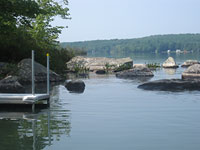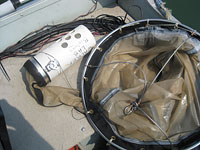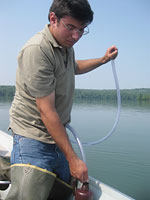

 | |||||||||||||
|
|
Journals 2009/2010Teresa Gable
August 17, 2009 Today, I traveled with Bill Locke to Togus Pond which is located in Augusta, ME. It is a small, freshwater lake. We launched the boat from the Lake Association Boat Launch and traveled to the deepest part of the lake to gather water samples and data. The deepest part of the lake was about 42 feet deep.
Alewives are not found in this pond yet. The researchers are studying this lake to collect data before alewives are introduced and a fish ladder is possibly constructed. We collected zooplankton with a large zooplankton net. We took samples from three different vertical tows and concentrated the zooplankton in specimen jars. The zooplankton will be analyzed in the lab.
Also, we collected 4 liters of water one meter from the surface. The water was stored in dark containers and will be analyzed for the amount of chlorophyll-a. Phytoplankton are photosynthetic microscopic organisms that contain chlorophyll-a. The amount of chlorophyll-a present will be an indicator of the amount of phytoplankton present. Phytoplankton are important because they are eaten by zooplankton and alewives eat the zooplankton.
The last task we performed was taking a temperature and dissolved oxygen profile of the sampling site. We measured the temperature and the percentage of dissolve oxygen at different depths using a probe. |
||||||||||||


